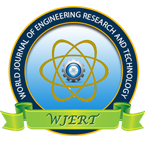| All | Since 2020 | |
| Citation | 172 | 110 |
| h-index | 7 | 5 |
| i10-index | 1 | 0 |
WJERT Citation 
Login
News & Updation
Abstract
DETERMINATION OF PRESSURE DROP ACROSS A RANGE OF INLET VELOCITY IN A STAIRMAND’S HIGH EFFICIENCY CYCLONE
*Oriaku E. C., Adizue U. L., Odenigbo J. O. and Ibeagha D. C.
ABSTRACT
The need to remove suspended dust from a gas stream has led to the development of several dust collection equipment operating on different principles in use in the industry today. Cyclone is a typical example of centrifugal dust collector. Since the discovery of cyclone about a century ago, a trend of consistent research work has characterized the progressive development of Cyclone separator. These research works has a common objective of providing optimum cyclones suited for specific purposes and which offer the most favorable collection efficiency at minimum cost. Pressure drop affects cost and cyclone collection efficiency. Several attempts has been made to calculate pressure drop from fundamentals but none of them has been very satisfying and hence practical measurement is adopted in this work to more accurately determine this parameter in the Stairrmand cyclone. Pitot static tubes were used to take reading at different points on experimental rig at both No-load and load basis as shown in Figure 1. The rig was run at ten (10) different entry velocities in each case and the pressure drop determined. The results show that both percentage fine particle collection and Entry velocities increases with increase in Pressure drop. Also optimum fine particle collection (Above 88%) can be achieved at a range of 22.64 to 54.8 N/m2 and 682.2 to 1158 x 60 m/min of pressure drops and Entry velocities respectively.
[Full Text Article] [Download Certificate]
